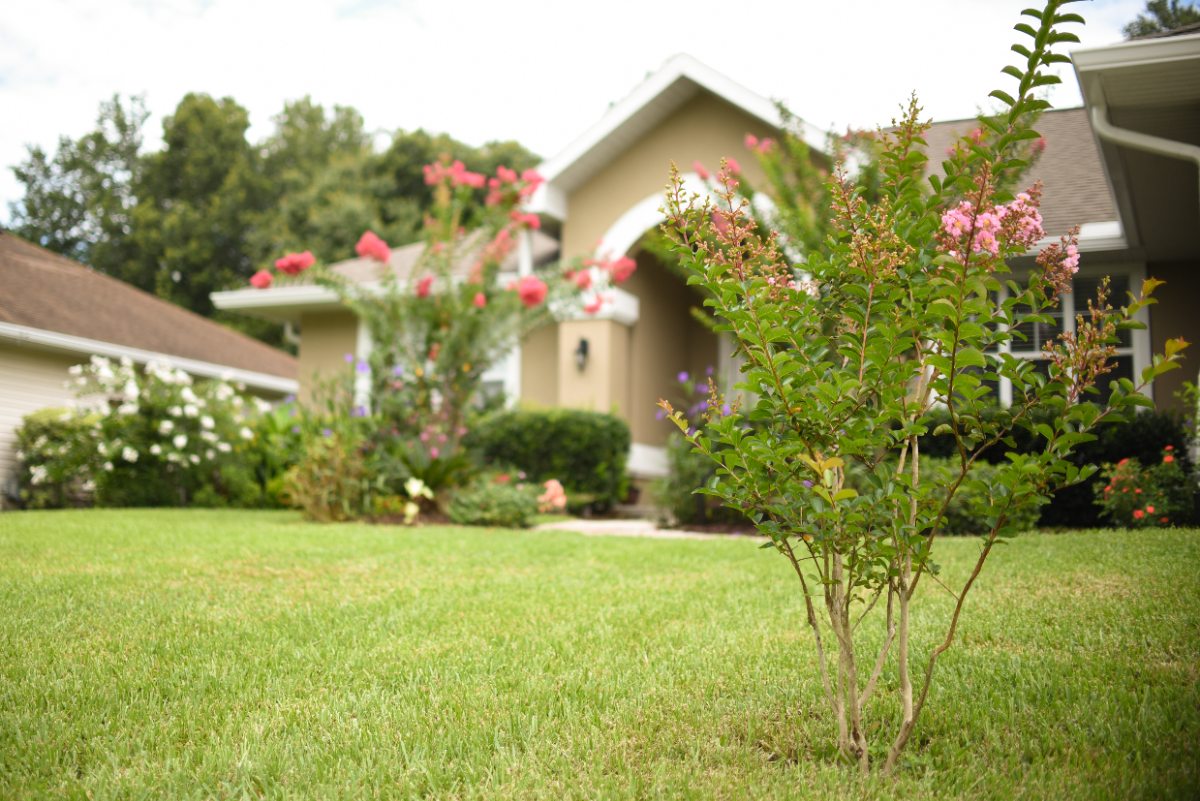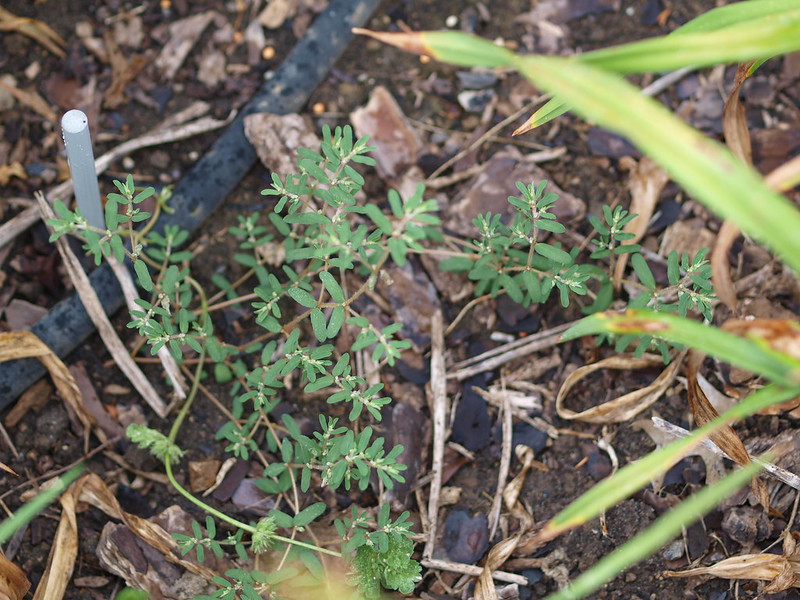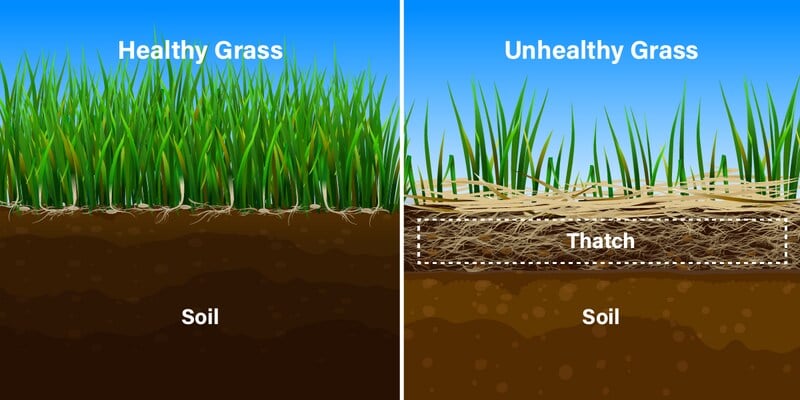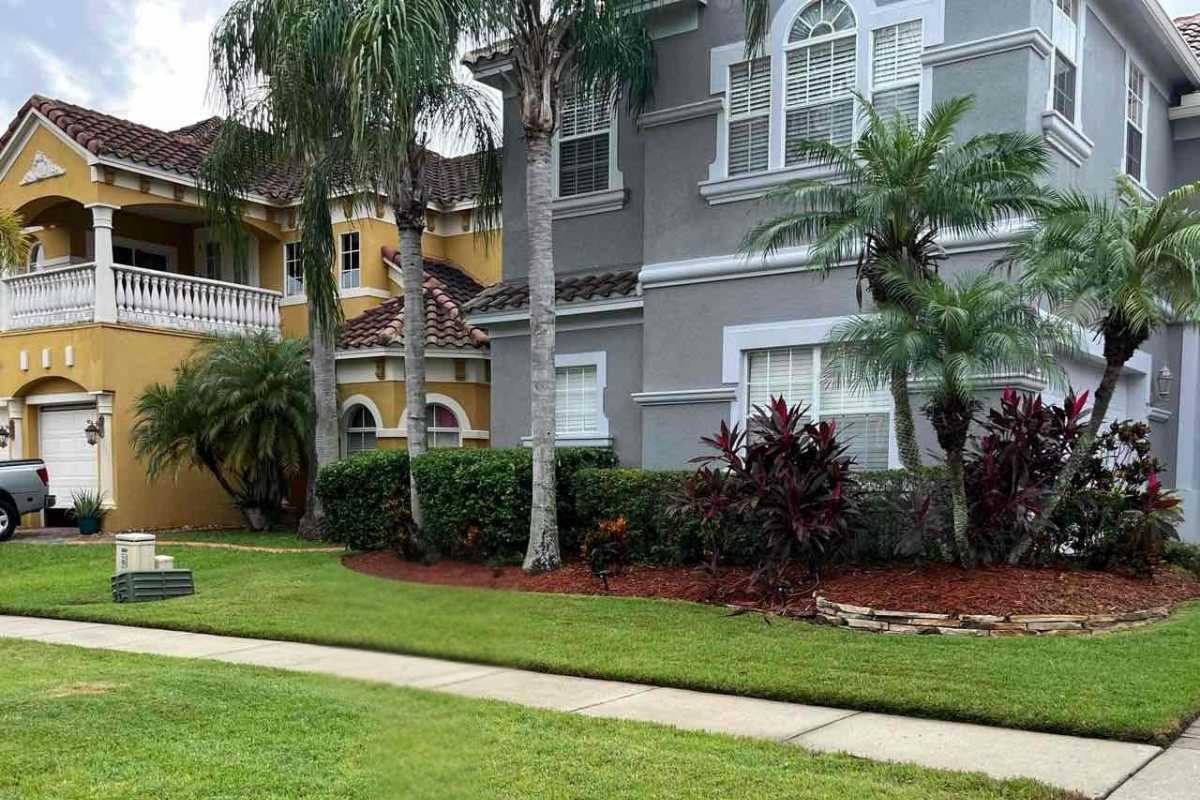
Every Orlando neighborhood has that one perfect lawn that stays green while yours turns brown. Want to know their secrets?
This guide reveals the best local tricks: from fertilizers high in potassium and iron applications in the summer to research-based watering schedules and expert tips for handling pests — all the basic secrets to effective lawn care in Orlando’s challenging climate.
- 1. Prioritize Good Drainage
- 2. Customize Your Watering Schedule
- 3. Stop Weeds from Sprouting
- 4. Use the Right Insecticide
- 5. Remove Thatch Over ½-Inch Thick
- 6. Aerate High Traffic Areas
- 7. Overseed for Weed Control and Winter Color
- 8. Fertilize in the Spring
- 9. Mow Tall and Mulch the Clippings
- 10. Watch for Diseases Year-Round
1. Prioritize Good Drainage
Anyone who’s lived through an Orlando summer knows the drill — it’s sunny at noon, then by 3 p.m., the sky opens up. Daily afternoon storms add water to Orlando’s lawns like clock-work, for weeks in a row. Add the hurricanes and the inches of rainfall they bring and, if your yard doesn’t drain properly, you’ll have standing water in your lawn for days.
That’s not just ugly; it’s a breeding ground for mosquitoes and can kill your grass from the roots up. If your lawn has drainage problems (puddles are visible days after the rain), try these fixes:
- Aerate the lawn and topdress with compost
- Install French drains or channel drains
- Build a catch basin
- Create a rain garden
- Extend downspouts away from the lawn and foundation
See Related:
- How to Get Rid of Mosquitoes in Orlando
- 7 Ways to Improve Drainage in Your Yard
- How To Keep Water Drainage Off Your Lawn
2. Customize Your Watering Schedule

The biggest mistake Orlando homeowners make in lawn care is “watering: either too little, or too much,” say Hannah Eason and Calvin Gardner, UF/IFAS Extension agents in Orange County.
When you water correctly, your lawn fights off bugs, diseases, and weeds better. So, how do you water the right way in Orlando?
Start by adjusting water amounts for each season. Here’s how much to use based on University of Florida research:
| Months | Irrigation Frequency and Amount |
| December-March | Water every 1-2 weeks; aim for 1/4-1/2 inch per week |
| April-September | Water 1-2 times a week; aim for 1-1 1/2 inches per week |
| October-November | Water 1-2 times a week; aim for 3/4-1 inch per week |
Watch your lawn and adjust the watering as needed. Your grass should look slightly stressed before you water again (bent grass blades, visible footprints left on your lawn).
Don’t water when it’s already raining. During the wet season, daily afternoon storms usually provide plenty of water.
- Florida law requires all automatic sprinkler systems to have working rain shut-off sensors. Orange County Utilities Water Division and Seminole County replace broken sensors for free.
- If you have a manual sprinkler, turn it off when it’s raining regularly.
Keep in mind that Orlando has year-round watering restrictions. Here are the main rules to follow:
- Water twice per week during Daylight Saving Time, and once per week during Eastern Standard Time, on designated weekdays
- Water early in the morning, between 4 a.m. and 9 a.m.
- Don’t apply more than 3/4 inch of water in one session
See Related:
- 11 Essential Lawn Watering Tips for Florida
- 10 Signs of Overwatering Your Lawn
- 8 Signs Your Lawn Needs Watering
3. Stop Weeds from Sprouting

Orlando’s hot and humid weather makes everything grow faster and stronger, including weeds. The best way to hold them back is to ensure healthy, dense grass that shades the soil, so:
- Mow tall
- Overseed thin grass and damaged patches
- Water and fertilize correctly
The second-best thing is to hit the weeds with a pre-emergent herbicide before they sprout. Timing is essential. Here’s a treatment schedule to help you plan:
| Weed Type | First Application | Second Application |
| Winter weeds: henbit, annual bluegrass, wild geranium, chickweed, lawn burweed | Mid-October to early-November | Mid-December |
| Summer weeds: crabgrass, dollarweed, buttonweed, chamberbitter, spotted spurge, Florida pusley | Mid-February | April |
The best pre-emergent herbicides for Orlando lawns include: prodiamine (Barricade), dithiopyr (Dimension), and pendimethalin (Pendulum). Atrazine works as a pre- and post-emergent herbicide, but it’s only safe to use on St. Augustine and centipede.
Some weeds will survive the preventive herbicides. Spot treat with post-emergent herbicides while young or hand pull if just a few here and there. Heat-stressed grass is vulnerable to herbicides; don’t apply when over 85 F-90 F.
See Related:
- How to Prevent Weeds from Growing in Your Lawn
- How to Get Rid of Weeds in Grass
- How to Remove Weeds From Gravel (7 Methods)
4. Use the Right Insecticide

Central Florida’s heat and humidity create a bug paradise where pests like chinch bugs, mole crickets, grubs, billbugs, and sod webworms can attack your lawn almost year-round. Proper lawn care is the first step to controlling these pests.
“Keep the lawn mowed and irrigated properly (pests love dry, stressed soil). Avoid piling mulch too high or leaving food sources (trash, pet food) outside,” says Orlando LawnStarter Pro Kody Robinson of ProCutz Lawncare Landscaping LLC.
Check your lawn every two weeks in the winter, and every 7-10 days from spring to fall to catch the pests while they’re still low in numbers.
Found bugs in your grass? Take a photo and email it to your local Extension office. Their experts will identify it and recommend treatment if needed.
Using insecticides in the Orlando area requires caution. Our sandy soil lets chemicals seep into the groundwater faster, and local bugs build resistance to overuse.
- Try eco-friendly pest control options first: insecticidal soap, beneficial nematodes, or biological insecticides.
- If using chemical insecticides, only treat damaged spots and rotate products.
Need to treat the whole lawn? Hire a local lawn pest control professional for severe infestations. They know the right products and amounts and can also set up prevention for next year.
See Related:
- How to Get Rid of Chinch Bugs on the Lawn
- How to Get Rid of Sod Webworms
- Lawn Grubs: How and When to Kill Them
- How to Get Rid of Mole Crickets in Your Lawn
- Bugs that Bite and Sting in Orlando
5. Remove Thatch Over ½-Inch Thick

Thatch feeds bugs and diseases, so keep it under 1/2-inch thick to prevent pests and fungi.
How often to dethatch the lawn in Orlando:
- Yearly for St. Augustine, Zoysia, Bermuda, and centipede — they create more thatch.
- Every 2-3 years for bahiagrass — it produces very little thatch buildup.
Dethatch the lawn in April or May, when the grass is actively growing. To avoid detaching too early, wait until you mow the lawn at least 2 times.
See Related:
6. Aerate High Traffic Areas

The Orlando metro area has sandy soil, less prone to compaction, so you’ll generally only need to aerate every 2-3 years. But there are exceptions.
You might need to aerate yearly if your lawn has:
- Clay soil (common in new construction)
- Heavy foot traffic from parties, barbecues, and kids playing
- Compaction from construction equipment or remodeling
Aerate the lawn in April or May when the grass is actively growing. That’s when it can benefit the most from the increased airflow and improved access to water and nutrients.
See Related: How to Test for Compacted Soil
7. Overseed for Weed Control and Winter Color
Fill in bare spots for a thicker, greener lawn and fewer weeds. Repair your lawn in April or May when warm-season grasses start growing here in the Orlando metro area.
- Overseed bahia, but repair Zoysia and centipede with plugs or sprigs. The fast-growing St. Augustine and resilient Bermuda usually self-repair if well-maintained.
- Buy the same cultivar or a similar one to avoid a patchy look.
Some Orlando homeowners overseed Bermuda with ryegrass in late fall to keep the lawn green during winter. If you do the same, choose endophytic rye — it has helpful fungi and helps fight lawn pests.
8. Fertilize in the Spring
“Use a slow-release nitrogen fertilizer, ideally with little or no phosphorus,” says Orlando LawnStarter Pro Vicente Vazquez of Cutting Edge Professional Landscaping.
That’s because Orlando soil is typically high in phosphorus. It’s also low in potassium, so the best fertilizers are those with a nitrogen to potassium ratio of 1:1 or 2:1.
From June 1 to Sept. 30, the Orlando area is in summer blackout: You can’t use nitrogen and phosphorus on your lawn. Spring remains the main window for feeding the grass. To make the most of it:
- Get a soil test first to check pH and nutrient deficiency.
- Wait until your lawn is at least 50% green before the first fertilization of the year (late March or early April).
- Apply a second round in late May for hungry grasses like St. Augustine and Bermuda.
What you CAN use during the summer ban:
- Micronutrients like iron, manganese, and magnesium
- Potassium fertilizer
- Biostimulants like humic acid and amino acids
- Organic matter: compost, compost tea, warm casting tea
Do the last application of the year in early October. Use a fertilizer high in potassium; it helps the grass recover from heat and prepare for the cold season.
Here are the recommended yearly nitrogen amounts for common types of grass in Orlando lawns.
| Type of Grass | Pounds of Nitrogen per Year per 1,000 sq. ft. in Central Florida |
| St. Augustine | 2-5 |
| Bahia | 1-2 |
| Bermuda | 4-6 |
| Centipede | 0.4-3 |
| Zoysia | 2-4 |

- Don’t apply over 1 pound of nitrogen per 1,000 square feet in one application.
- Use products with at least 50% to 65% slow-release nitrogen.
- Mulching grass clippings ensures up to 25% of the nitrogen your lawn needs.
Note: Don’t treat the lawn during dry, stressful days when temperatures are over 90 F or when you expect heavy rain.
See Related:
- How to Read a Soil Test Report
- When to Test the Soil pH of Your Lawn
- The Best Lawn Fertilization Schedule and Tips for Florida
- 6 Different Nitrogen Sources for the Lawn
- 5 Tell-Tale Signs Your Lawn Needs Fertilizer
9. Mow Tall and Mulch the Clippings
Orlando’s relentless summer heat and blazing sun can burn your lawn. Keeping the grass taller helps it survive by cooling the soil, retaining moisture more effectively, and growing stronger roots.
“Many homeowners mow their lawns too short, thinking it reduces mowing frequency. But in Orlando’s hot, humid climate, especially with St. Augustine or bahiagrass, scalping causes brown, patchy lawns, thriving weeds, weak root systems, and burnout during dry weeks,” says lawn care pro Robinson.
Here’s how high to cut your grass and how to adjust for the seasons:
| Type of Grass | Optimal Mowing Height (Inches) | Mowing Frequency (Days) |
| St. Augustine | 3-4 | 5-14 |
| Bahia | 3-4 | 7-17 |
| Zoysia | 0.5-1.5 | 3-5 |
| Bermuda | 1.5-2 | 10-14 |
| Centipede | 1-2 | 10-14 |
- Spring: Cut 1/2 inch lower to improve sun exposure and speed up growth.
- Summer: Mow tall (close to the maximum recommended height) to protect the roots from heat and drought. Increase mowing frequency if necessary.
- Fall: Reduce mowing height in Bermuda if you overseed with rye.
- Winter: Mow the grass at the maximum recommended height and reduce mowing frequency to once every 3-4 weeks.
| Let Orlando LawnStarter pros adjust mowing height and frequency for you. Our pros charge on average $51 for mowing a 1/4-acre lawn and maintain a 4.5-star customer rating. |
If possible, leave the grass clippings on the lawn, especially during the summer fertilizer ban. They feed the lawn naturally with nitrogen, while protecting local springs and lakes from pollution.
Read Next:
10. Watch for Diseases Year-Round

Orlando’s mild winters and humid summers make fungal infestations more aggressive, and some can be active year-round.
Watch for signs of fungi even during winter. If you find any, send samples for identification to the local Extension Office. They’ll recommend suitable fungicides for treatment.
Some grasses are more susceptible to certain diseases. Here’s what to pay attention to by type of grass:
| Type of Grass | Primary Concern | Other Common Diseases |
| St. Augustine | Gray leaf spot | Large patch, take-all root rot |
| Bahiagrass | Dollar spot | |
| Bermuda | Large patch | Dollar spot, leaf spot and melting out |
| Centipede | Large patch | Dollar spot |
| Zoysia | Large patch | Dollar spot, rust |
When it’s Time to Call the Pros

In Orlando’s challenging climate, proper lawn care is key, and guesswork can be costly. Hire an Orlando LawnStarter pro and ensure your lawn is perfectly mowed, dethatched, and fertilized — the best way to keep weeds, pests, and diseases at bay.
Living in Winter Park, Kissimmee, Apopka, or Altamonte Springs? No worries. LawnStarter has pros all across the Orlando metro area to help keep your lawn healthy and thriving.
Sources:
- Calvin Gardner, urban horticulture extension agent at the University of Florida, Orange County Extension, Orlando, FL. Personal interview.
- Hannah Eason, commercial horticulture extension agent at the University of Florida, Orange County Extension, Orlando, FL. Personal interview.
- “Operation of Residential Irrigation Timers.” By irrigation and horticulture specialists Michael D. Dukes, Bernard Cardenas, and Dorota Z. Haman. University of Florida.
- “Lawn Care & Irrigation.” University of Florida Extension
- “Spring is Dry Season in Central Florida—Check Irrigation Systems!” By Hannah Eason, commercial horticulture extension agent. University of Florida Orange County Extension.
Main Image: Crepe myrtle in a Florida lawn. Photo Credit: Tanya / Adobe Stock